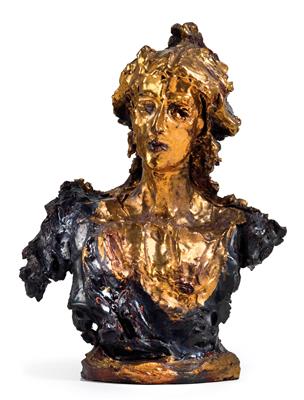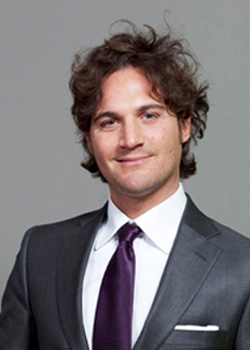Lucio Fontana *

(Rosario di Santa Fe, Argentina 1899–1968 Comabbio)
Busto di donna, 1949, terracotta, painted, glazed, signed and dated L.Fontana 49 on the base, 59 x 44 x 27 cm, (AR)
The work has been registered by the Fondazione Lucio Fontana under the archive no. 3952/1.
Photo certificate:
Fondazione Fontana, Milan, archive no. 3952/1
Provenance:
Roberto Olivetti, Milan
Fondazione Maria Gabriella di Savoia (gift from Roberto Olivetti, Milan 1963, on the occasion of a charity auction to support children with heart defects)
Angelo Campiglio, Milan
European Private Collection
Exhibition:
Milan, Palazzo della Permanente, Mostra di opere di artisti moderni, a favore della Fondazione Maria Gabriella di Savoia per l’assistenza ai bambini cardiopatici, 3 - 7 April 1963, exh. cat. no. 76, with ill.
Literature:
Enrico Crispolti, Lucio Fontana. Catalogo generale, Electa, Milan 1986, Volume I, p. 91, with ill.;
Enrico Crispolti, Lucio Fontana. Catalogo ragionato di sculture, dipinti ambientazioni, Skira, Milan 2006, Volume I, p. 212, no. 48
“The material was inviting, I was able to shape an ocean floor, a statue or a tuft of hair and apply pure and compact paint that would melt in the fire. The fire worked almost like a go-between: colour and shape were thereby bound together forever”. (Lucio Fontana, 1939)
Famous around the world for his Slashes and Holes, Lucio Fontana began his artistic career as a sculptor in the early 1920s, following in the footsteps of his father Luigi. In 1924 Fontana had his own studio in Rosario, in the Argentine province of Santa Fè, and in 1928 he visited Milan where he studied with Adolfo Wildt at Accademia di Brera. In this “classic” period, Fontana followed the example of his teacher Wildt and of Artistide Maillol, whose sculptures were characterized by smooth surfaces and clear outlines.
In 1929 and 1930, Fontana’s career as a sculptor took a remarkable turn with works characterized by an ever increasing personal immediacy often assuming vivid archaic shapes. But the ultimate turning point came in early 1931, when his sculptures acquired such an involuntary spontaneity and dynamism, with the use of colour also assuming greater importance. The material began to arrange itself in space while observing the greatest possible freedom of expression. To quote the critic Guido Piovene, this “creates scenic sculptures (…) that are reminiscent of damp, crudely made clay sculpture on which the thumb print is still visible, but that suddenly change into valuable matter”.
After a short excursion into abstract sculpture in 1934, Fontana, always distinguished by creative freedom and vitality, explored new and highly important territory. Between 1935 and 1940 he worked ceramics at artist Tullio Mazzotti’s workshop in Albisola. Here the restless sculptor discovered that “clay is the best means of expressing the personal problem of blending painting and sculpture”. (Attilio Podestà, “Broletto” 1983) In those years Fontana spent time at the Sèvres manufactory acquiring knowledge and experimenting with ceramics, sandstone and clay. Informal art and neo-baroque expressionism, representativeness and abstraction, meditation and spontaneity, all created a familiar and elaborate balance that had an enriching effect on the subjects he dealt with.
Vases and plates with representational elements began to emerge from the furnace in Albissola; some were narrative depictions, others had an almost symbolic character: battle scenes, masks, warriors, but also madonnas and crucifixions. In the 1940s and 1950s, Fontana increasingly concentrated on sculpture and achieved a technical capacity that enabled him to let his inspiration run free.
Works of this period are the ones presented on this occasion: a golden female bust, two plates with masks and a crucifixion, where Catholic pomp, “barbarità india”, Venetian and Mediterranean cadences as well as reminiscences of the 17th century (to use the words of Marco Valsecchi) are perfectly orchestrated by Fontana’s wild imagination and melt into spontaneous, expressive and extremely vivid creations.
Expert: Alessandro Rizzi
 Alessandro Rizzi
Alessandro Rizzi
+39-02-303 52 41
alessandro.rizzi@dorotheum.it
10.06.2015 - 19:00
- Dosažená cena: **
-
EUR 588.533,-
- Odhadní cena:
-
EUR 160.000,- do EUR 220.000,-
Lucio Fontana *
(Rosario di Santa Fe, Argentina 1899–1968 Comabbio)
Busto di donna, 1949, terracotta, painted, glazed, signed and dated L.Fontana 49 on the base, 59 x 44 x 27 cm, (AR)
The work has been registered by the Fondazione Lucio Fontana under the archive no. 3952/1.
Photo certificate:
Fondazione Fontana, Milan, archive no. 3952/1
Provenance:
Roberto Olivetti, Milan
Fondazione Maria Gabriella di Savoia (gift from Roberto Olivetti, Milan 1963, on the occasion of a charity auction to support children with heart defects)
Angelo Campiglio, Milan
European Private Collection
Exhibition:
Milan, Palazzo della Permanente, Mostra di opere di artisti moderni, a favore della Fondazione Maria Gabriella di Savoia per l’assistenza ai bambini cardiopatici, 3 - 7 April 1963, exh. cat. no. 76, with ill.
Literature:
Enrico Crispolti, Lucio Fontana. Catalogo generale, Electa, Milan 1986, Volume I, p. 91, with ill.;
Enrico Crispolti, Lucio Fontana. Catalogo ragionato di sculture, dipinti ambientazioni, Skira, Milan 2006, Volume I, p. 212, no. 48
“The material was inviting, I was able to shape an ocean floor, a statue or a tuft of hair and apply pure and compact paint that would melt in the fire. The fire worked almost like a go-between: colour and shape were thereby bound together forever”. (Lucio Fontana, 1939)
Famous around the world for his Slashes and Holes, Lucio Fontana began his artistic career as a sculptor in the early 1920s, following in the footsteps of his father Luigi. In 1924 Fontana had his own studio in Rosario, in the Argentine province of Santa Fè, and in 1928 he visited Milan where he studied with Adolfo Wildt at Accademia di Brera. In this “classic” period, Fontana followed the example of his teacher Wildt and of Artistide Maillol, whose sculptures were characterized by smooth surfaces and clear outlines.
In 1929 and 1930, Fontana’s career as a sculptor took a remarkable turn with works characterized by an ever increasing personal immediacy often assuming vivid archaic shapes. But the ultimate turning point came in early 1931, when his sculptures acquired such an involuntary spontaneity and dynamism, with the use of colour also assuming greater importance. The material began to arrange itself in space while observing the greatest possible freedom of expression. To quote the critic Guido Piovene, this “creates scenic sculptures (…) that are reminiscent of damp, crudely made clay sculpture on which the thumb print is still visible, but that suddenly change into valuable matter”.
After a short excursion into abstract sculpture in 1934, Fontana, always distinguished by creative freedom and vitality, explored new and highly important territory. Between 1935 and 1940 he worked ceramics at artist Tullio Mazzotti’s workshop in Albisola. Here the restless sculptor discovered that “clay is the best means of expressing the personal problem of blending painting and sculpture”. (Attilio Podestà, “Broletto” 1983) In those years Fontana spent time at the Sèvres manufactory acquiring knowledge and experimenting with ceramics, sandstone and clay. Informal art and neo-baroque expressionism, representativeness and abstraction, meditation and spontaneity, all created a familiar and elaborate balance that had an enriching effect on the subjects he dealt with.
Vases and plates with representational elements began to emerge from the furnace in Albissola; some were narrative depictions, others had an almost symbolic character: battle scenes, masks, warriors, but also madonnas and crucifixions. In the 1940s and 1950s, Fontana increasingly concentrated on sculpture and achieved a technical capacity that enabled him to let his inspiration run free.
Works of this period are the ones presented on this occasion: a golden female bust, two plates with masks and a crucifixion, where Catholic pomp, “barbarità india”, Venetian and Mediterranean cadences as well as reminiscences of the 17th century (to use the words of Marco Valsecchi) are perfectly orchestrated by Fontana’s wild imagination and melt into spontaneous, expressive and extremely vivid creations.
Expert: Alessandro Rizzi
 Alessandro Rizzi
Alessandro Rizzi
+39-02-303 52 41
alessandro.rizzi@dorotheum.it
|
Horká linka kupujících
Po-Pá: 10.00 - 17.00
kundendienst@dorotheum.at +43 1 515 60 200 |
| Aukce: | Současné umění |
| Typ aukce: | Salónní aukce |
| Datum: | 10.06.2015 - 19:00 |
| Místo konání aukce: | Wien | Palais Dorotheum |
| Prohlídka: | 30.05. - 10.06.2015 |
** Kupní cena vč. poplatku kupujícího a DPH(Země dodání Rakousko)
Není již možné podávat příkazy ke koupi přes internet. Aukce se právě připravuje resp. byla již uskutečněna.
